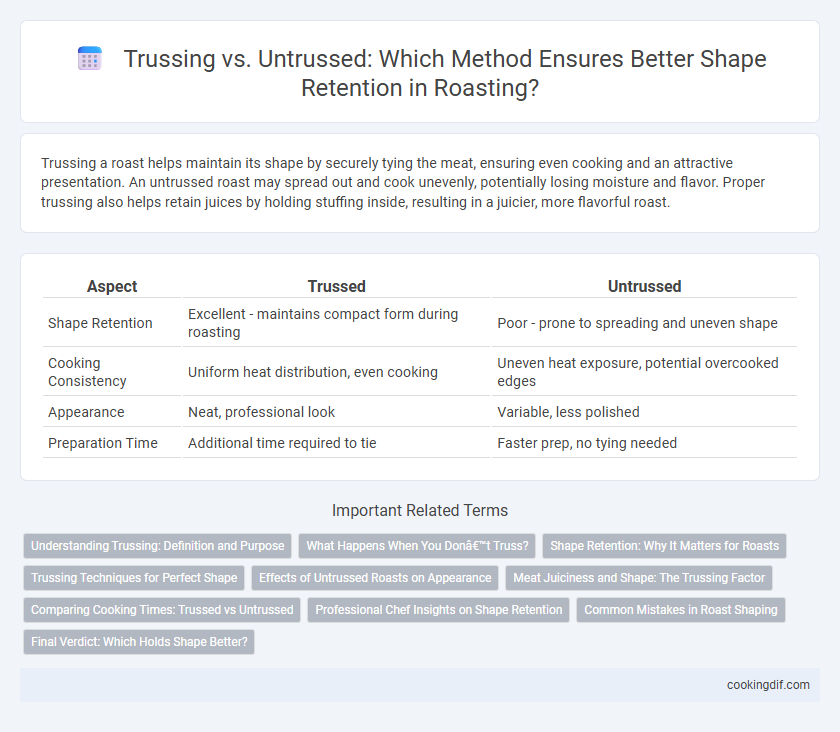Trussing a roast helps maintain its shape by securely tying the meat, ensuring even cooking and an attractive presentation. An untrussed roast may spread out and cook unevenly, potentially losing moisture and flavor. Proper trussing also helps retain juices by holding stuffing inside, resulting in a juicier, more flavorful roast.
Table of Comparison
| Aspect | Trussed | Untrussed |
|---|---|---|
| Shape Retention | Excellent - maintains compact form during roasting | Poor - prone to spreading and uneven shape |
| Cooking Consistency | Uniform heat distribution, even cooking | Uneven heat exposure, potential overcooked edges |
| Appearance | Neat, professional look | Variable, less polished |
| Preparation Time | Additional time required to tie | Faster prep, no tying needed |
Understanding Trussing: Definition and Purpose
Trussing involves tying the roast with kitchen twine to hold its shape during cooking, ensuring even heat distribution and a uniform, attractive appearance. This technique prevents the meat from spreading out or becoming misshapen, which helps maintain juiciness and enhances presentation. Proper trussing locks in the roast's natural form, leading to consistent cooking and improved texture.
What Happens When You Don’t Truss?
When you don't truss a roast, the meat often cooks unevenly, causing irregular shape retention and potential dryness in exposed areas. Loose limbs or wings tend to spread out, increasing the risk of overcooking thinner parts while the thicker sections remain underdone. Without trussing, the roast's exterior surface can become less compact, leading to a less uniform crust and inconsistent texture.
Shape Retention: Why It Matters for Roasts
Shape retention in roasts ensures even cooking and an appealing presentation, preserving the meat's uniform texture and juiciness. Trussing helps maintain the roast's compact form, preventing uneven shrinkage and promoting consistent heat distribution throughout. Untrussed roasts may lose shape, causing longer cooking times and an uneven final product, impacting both flavor and aesthetics.
Trussing Techniques for Perfect Shape
Trussing techniques secure the roast tightly, ensuring consistent shape retention and even cooking throughout. Using kitchen twine or specialized trussing needles maintains the meat's compact form, preventing uneven spreading or drying of exposed surfaces. Properly trussed roasts achieve optimal texture and presentation by promoting uniform heat distribution and moisture retention.
Effects of Untrussed Roasts on Appearance
Untrussed roasts often result in uneven cooking and a less compact appearance due to the loose structure allowing the meat to spread during roasting. This can cause a rough or irregular shape, reducing the visual appeal and uniformity typically desired in presentation. Without trussing, the roast may develop a more rustic look but lacks the tidy, consistent form achieved through proper trussing techniques.
Meat Juiciness and Shape: The Trussing Factor
Trussing a roast tightly preserves its shape, preventing uneven cooking and moisture loss, which enhances meat juiciness. Untrussed roasts tend to spread out during cooking, causing inconsistent heat distribution and potential dryness. Maintaining a compact form through trussing ensures even cooking and optimal retention of the roast's natural juices.
Comparing Cooking Times: Trussed vs Untrussed
Trussed roasts typically cook more evenly and retain their shape better, often requiring slightly longer cooking times compared to untrussed roasts due to restricted heat penetration. Untrussed roasts may cook faster as heat circulates more freely but can lose shape and result in uneven cooking. For optimal results, adjusting cooking times by approximately 10-15% longer for trussed roasts ensures thorough doneness while maintaining a uniform shape.
Professional Chef Insights on Shape Retention
Professional chefs emphasize that trussing a roast ensures uniform cooking and maintains a compact, consistent shape, preventing the meat from sprawling during roasting. Without trussing, the roast may lose its form, leading to uneven heat distribution and compromised texture. Trussing integrates culinary techniques with precise shape retention, enhancing both presentation and flavor development.
Common Mistakes in Roast Shaping
Common mistakes in roast shaping often involve neglecting trussing, which compromises shape retention and even cooking. Untrussed roasts can become unevenly browned and misshapen due to inconsistent heat distribution during roasting. Proper trussing secures the meat, maintaining a uniform shape that enhances both appearance and internal temperature control.
Final Verdict: Which Holds Shape Better?
Trussed roasts maintain shape better by securing limbs close to the body, preventing uneven cooking and moisture loss. Untrussed roasts may spread out during cooking, leading to less uniform shape but potentially more surface caramelization. For optimal shape retention and presentation, trussing is the recommended method.
Trussing vs Untrussed for Shape Retention Infographic

 cookingdif.com
cookingdif.com